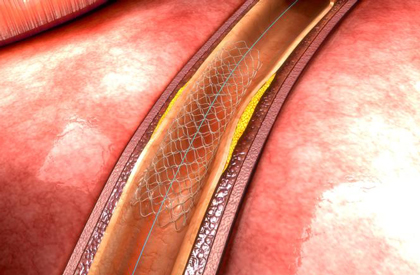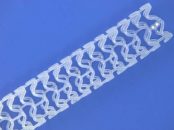Recent studies have shown that drug-eluting stents with biodegradable polymer and ultrathin struts are safe and effective, including low rates of stent thrombosis. This is why researchers conducted the BIODEGRADE (Biomatrix and Orsiro Drug-Eluting Stents in Angiographic Result in Patients With Coronary Artery Disease) study, which showed the non-inferiority at 18 months of ultrathin biodegradable polymer…
EMINENT Trial | Stent Eluvia vs BMS in Femoropopliteal Territory
Endovascular therapy in femoropopliteal territory has become the standard, mainly with self-expanding stents, aimed at preventing early vascular recoil and late constrictive remodeling. Randomized studies have shown that the use of Paclitaxel drug eluting stents (DES) reduces the number of new revascularizations (even though these studies compared mostly against conventional balloons, which is why we…
Longitudinal Deformation of a Stent with the POT Technique
The fractal geometry of coronary bifurcations offers a mismatch between the proximal diameter of the main branch and the distal branches that make up the bifurcation. Angioplasty in this area can be performed through different techniques depending on plaque distribution, and the particular geometry of each bifurcation. Overall, and regardless of the strategy used, there…
Everolimus-Eluting Stents Finally Have a Rival and Not Just a “Non-Inferior” Stent
In this large randomized trial, there were significant differences as regards both target-lesion failure and target-vessel-related infarction, which persisted through a 2-year follow-up and favored treatment with an ultrathin-strut bioresorbable-polymer sirolimus-eluting stent (Orsiro) compared with the gold standard, a durable-polymer everolimus-eluting stent (Xience). Moreover, there were significantly lower rates of target lesion revascularization and late/very…
New Strategies for the Femoropopliteal Artery
Courtesy of Dr. Carlos Fava. The incidence of peripheral vascular disease is clearly increasing, progressing towards critical ischemic claudication and amputation. Angioplasty is currently the treatment of choice for these pathologies. Several times, an implanted stent ends up cracking due to extensive calcification, increasing the rate of restenosis and worsening critical ischemia. Technological development on drug-eluting…
Are Bioresorbable-Polymer Stents More Thrombogenic than Durable-Polymer Second-Generation Stents?
Courtesy of Dr. Cristian Jesús Rodríguez. Most stents currently used in percutaneous coronary intervention (PCI) are durable-polymer second-generation drug-eluting stents (DP-DES, with everolimus or zotarolimus). However, it has been argued that the persistence of such a polymer after complete drug elution is one of the main factors for a dangerous complication: stent thrombosis (ST). After…
Post DES Dual Antiplatelet Therapy Still under Debate
The NIPPON trial (Nobori Dual Antiplatelet Therapy as Appropriate Duration) was a randomized study comparing a short dual antiplatelet therapy scheme (6 months) vs. a prolonged scheme (18 months) in patients receiving the Nobori drug eluting stent (Terumo, Tokyo, Japan) with a biodegradable abluminal polymer. It included 3,773 patients with chronic stable angina or acute coronary…
Glycemic control and risk of repeat revascularization
The association between glycemic control after coronary angioplasty and outcomes of the latter is controversial in many studies. We have come to think that the risk lies in suffering from diabetes, as if it was an unmodifiable factor. We have also come to believe that glycemic control can impact microvascular complications while it cannot do…
The use of IVUS in unprotected left main PCI associated to better outcomes, compared to angiography guided PCI
Courtesy of Dr. Gustavo Leiva. Coronary Artery Bypass Graft (CABG) has traditionally been the procedure of choice in patients with left main coronary artery disease. However, the use of percutaneous techniques in this kind of lesions has been on the rise, partly due to recent research showing similar outcomes with both procedures. Unprotected left main…
Biodegradable-polymer stents are as safe as permanent-polymer stents in a 5-year follow-up
Courtesy of Dr. Carlos Fava. One of the questions around drug-eluting stents (DES) is whether the development of biodegradable polymers would derive in better outcomes than the performance of durable polymers as regards the presence of events. In consequence, the COMPARE II trial was carried out with the aim of testing them in “real-world” patients. This…
- 1
- 2









